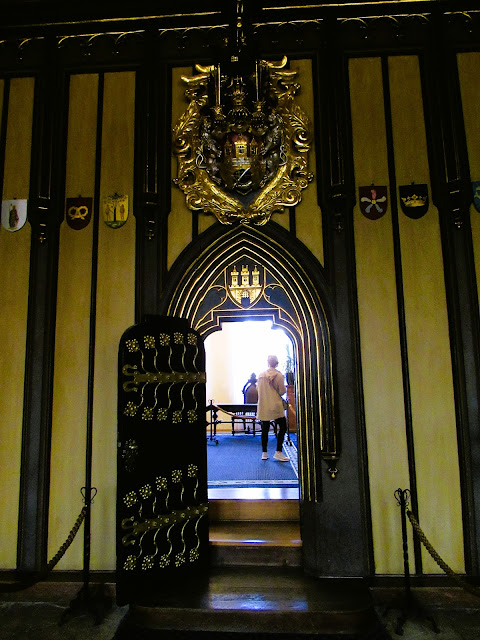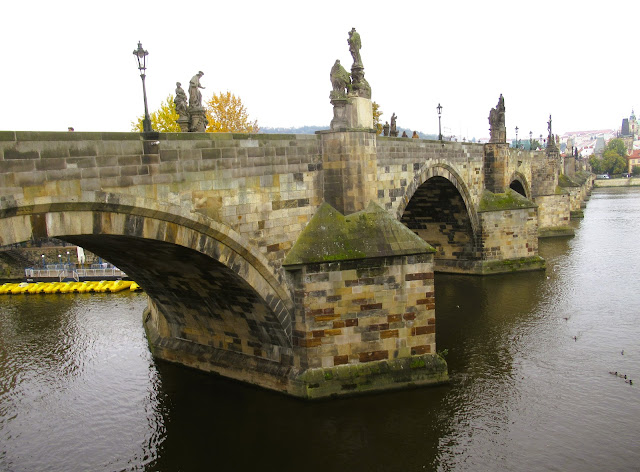Since this is being written about a month after being in the Czech Republic, we can say unequivocally that Prague has been our favourite city on this journey. It would be lovely to come and just stay for several months to get to know her better.
We had planned several stops in Czechia before getting to the capital city, but the miserable weather had us cut them all out except for Prague and Cesky Krumlov.
Our accommodation was an apartment right across from the Prague Florenc bus station. It was very handy for arrival after a long day of travel and for getting in late from day trips. It was quiet; an effortless twenty-five-minute walk to Centro; and there was a grocery store around the corner. There is a little restaurant/bar on the ground floor of Residenze David's Apartments that was especially convenient on arrival day.
Prague is full of surprising architecture, so you never know what is around the corner. This city has so many architectural styles: Gothic, Renaissance, Baroque, Cubist, Rococo and even a Brutalist building.
All parts of the historic center: Old Town, including the Jewish Quarter (or Josefov) Lesser Town and New Town, are designated as one UNESCO World Heritage Site, including the Castle District.
Every walk is a new adventure. There are wide people-friendly plazas with street food carts and public seating, narrow cobblestone streets, numerous bridges to cross the Vltava River, talented street musicians, beautiful parks and gardens and it feels completely safe. There is an interesting mix of old and new. Of course, Prague has some of the best beer in the world and some of the loveliest glass art.
Prague has embarked on an exciting revitalization of a four km stretch of its riverfront. Large vaults built into a stone wall that used to be for ice storage are being redesigned as cafes/bars, studios, workshops, galleries, a library branch, neighbourhood meeting rooms and public toilets. The enormous round vault windows that can rotate open are a unique feature that merges the inside with the outside. A floating pool with all the amenities is another part of the project. This link will give you a glimpse of what the future holds.
Everything here is quite affordable: restaurants, groceries, theatre, opera, and museums. As seniors, we could ride city buses for free and were given a considerable discount on intercity buses.
Our first full day starts with a Guru walk of Old Town and the Jewish Quarter, starting at the Rudolfinum building, home to the Czech Philharmonic Orchestra, a contemporary art gallery and an upscale cafe.
 |
| Some of the 12 apostles that rotate out of the clock |
 |
| Cast iron stove |
Prague is known as the 'City of a Thousand Spires'. While the Church of Our Lady Before Tyn is one of the most obvious examples of one spire being larger (Adam) than the other (Eve) there are several other buildings that follow this pattern.
Old Town Prague originally had thirteen city gates to welcome visitors. Today the only two that remain are the Powder Tower and the Tower at Charles Bridge on the Old Town side.
The Powder Tower was intended to be an attractive entrance, but through history and conflict ended up becoming a defensive tower that stored gunpowder (thus the name).
 |
| Powder Tower/Gate |
We never time it right for a tour of the inside but here is a photo from the concert hall. Photo used with permission with citation.
 |
Municipal House. (2022, July 28). In Wikipedia.
https://en.wikipedia.org/wiki/Municipal_House. By
© Jorge oyan / http://www.royan.com.ar, CC BY-SA 3.0, https://commons.wikimedia.org/w/index.php?curid=19169481 |
On the other side of the bridge lies Lesser Town and Kampa Island (voted one of the most beautiful city islands in the world). Walking here is a pleasant way to spend an afternoon. There are a variety of museums.
The enormous baby statues in the collage below are cute from behind until you see their face. This is more public art by David Cerny. In place of facial features, there is 'code'. The artist meant it to symbolize scary technological advances.
 |
| Statues here are from all over the city, not just on Kampa Island |
It's Trdelnik !! All over Prague these 'Chimney Cakes' are sold. Each vendor tries to outdo the other with what is put in them and the decoration. Frankly, one looked like a two-day calorie intake, so we passed. They are immensely popular. Below is a picture of the cake being cooked on a spit over an open fire. Go here to see photos of assembled Trdelnik.
Here too is an amazing Gallery of Steel Figures housed in an art nouveau building. It holds over a hundred figures all made from scrap metal and waste. There are figures from science fiction, fantasy, fairytales, and pop culture. There are animals and vehicles. Everyone is invited to touch, climb, play, and sit on them. And when you need a rest, there's a cafe onsite.
Hradcany Square is the entry point to the Castle complex. The quality of street food here is great. One woman has a booth that sells only potatoes in quite a variety of dishes. Mushrooms are featured by many booths, and of course traditional meats. Most of the food is cooked in these enormous cast iron pots.
The Prague Castle complex was started in the ninth century for the Bohemian Kings and continued to be built over several hundred years. Today it is the seat of the President of the Czech Republic. It's the largest ancient castle in the world and covers eighteen acres. The Crown Jewels are kept here.
On another day we head out for a
three-hour bus ride each way to daytrip from Prague to Český Krumlov in the
southern Bohemia part of Czechia. Protected as a UNESCO World Heritage Site its
now the second most visited place in the country after beautiful Prague. It boasts
Gothic, Renaissance and Baroque architecture, preserved in a street layout from
the Middle Ages.
Arriving at the main square, clearly, a free walking tour is about to begin. The guide graciously allows us to join in. He grew up here and his family is involved in both the restaurant and hotel businesses, so his stories are personal and full of warmth and humour.
Krumlov means bend in the meadow after a bend of the Vltava River (see map below). The word Český was added later, meaning Bohemia to differentiate it from another Krumlov. You will see that the historical core, is within a horseshoe bend of the river, with the old town part and castle complex is on the other side of the Vltava. In 2002 it suffered damage from the European Flood.
This area by the river has been
permanently inhabited since the Older Stone Age (70,000 – 50,000 BC).
Much of the city fell into disrepair during the Communist occupation. Then after the Velvet Revolution of 1989 that ousted the Communists, much restoration was done.
Český Krumlov Castle is one of the largest in central Europe with an area of seventeen acres. It is made up of forty buildings and palaces, situated around five castle courts and a castle park. Our time was limited to touring outside only. The inside can be toured with a Google search. One of the many unique things about this castle is that its moat is not filled with water, but with (3) bears.
We are so glad we went there; the
city is lovely. Our guide tells us that only three hundred live in the
historical center now. Everyone else has turned their buildings into
restaurants, pensions or storefronts for the thriving tourist trade and moved
outside of the center.
In the photos below you will see
beautiful signage, a unique shuttering system that many storefronts use and so
much more.
 |
| The horseshoe-shaped bend is easy to see from above. |
 |
| A friend of ours got to do a float on the river. That would be interesting. |
 |
| Castle Tower from afar. |
In the photo below, we have wondered about this old finishing technique also seen in Prague. The brown sandstone is surfaced with a white concrete-type finish, then when dry, part of that is scraped away by hand on each block to create a certain pattern. The first photo is of the "envelope" style.
 |
| Waterwheel with statue on its left and building signage on the right. |
The next three photos are a few of the great signs around town.
 |
| Love all the door shutters |
 |
| No wrought iron bars for the outsides of these windows, only beautiful scenes. |
On the photo above: On the left is the oven used to make gingerbread here. On the right traditional gingerbread. On the wall àre old patterns for display not eating. Check out the delicate decoration with white icing (bottom right). Those are for eating.
The shop in the photo below had the most beautiful hand-painted ... well, everything. The owner had two shops in town, with some variety in product. The leather goods are imported from Italy. He is the designer and artist and has several artists who work for him.
 |
| Rainspout! |
 |
| We don't know where these lovely ladies were headed, but they were happy to pose for us. |
BACK to PRAGUE for ONE MORE DAY
We want to end by sharing photos of some of the ornamentation on buildings in Prague that delighted us, and of course some of the beautiful buildings.
 |
| Handmade shoes. |
 |
| One of Paul's favourite cars. |






































































No comments:
Post a Comment